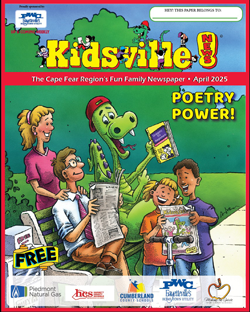
Dahle is president of the Cape Fear Amateur Radio Society, a 130-member-strong amateur ham radio organization in Cumberland County. The CFARS routinely steps up to help local emergency responders with radio communication services during hurricanes, blizzards or any other community crisis. When the call comes, members set up in local disaster shelters and provide communication via ham radios, while other forms of communication may have been affected by outages.
Dahle and his compatriots recently spent a hot Friday afternoon setting up antennas to prepare for the following day’s Field Day, an annual event testing the club’s ability to set up and communicate with other amateur radio organizations throughout the United States and Canada.
“This was a readiness exercise to determine the ability of CFARS to provide communication support to the community in emergency operations and disasters,” Dahle said. He emphasized this was not a contest to see how many radio contacts were made, although contacts are tracked and tabulated. “There are numerous varied contests throughout the year in different disciplines of communication where the main goal is purely a number count.”
CFARS held its annual Field Day on Saturday through Sunday, June 25 to 26, at the Hope Mills Golfview Greenway Walking Trail. The field day spans a continuous 24 hours, from 2 p.m. Saturday through 2 p.m. Sunday. The event is held under the auspices of the American Radio Relay League, the national association for amateur radio in the United States founded in 1914.
This was the first year CFARS held the event at the Hope Mills Walking Trail. In the past, CFARS’ Field Day took place at Methodist University, which also housed the group’s repeater. The previous chancellor of the University was a CFARS member.
Among ARRL’s missions is promoting and recruiting people into the amateur radio hobby. But another key job of ARRL is to protect radio frequencies used by amateur radio organizations and ensure they remain available to the public. Radio frequencies are limited, and someone always vies for Federal Communications Commission-controlled radio frequencies.
The annual readiness exercise and Field Day occur in the United States, Canada and even some worldwide locations may participate. It is held on the fourth full weekend in June. Along with testing their ability to function properly in the event of an emergency, amateur radio operators try to make voice or Morse code contact with as many other amateur radio operators as possible.
The CFARS’s setup at the Golfview Greenway site included a Morse code station, a Get-On-The-Air station, and a voice communications station. A GOTA station allows people without a radio license or newly licensed individuals to speak and connect with someone on ham radio. It gives someone a chance to experience first-hand radio communication.
The ARRL website provided 2022 Field Day locations throughout the United States for interested citizens or news media. In North Carolina alone, there were dozens of sites, including Dublin, Calabash, New Bern, Jacksonville, Robbins, Albemarle atop Morrow Mountain and in the mountains of West Jefferson, among many others.
Local radio enthusiasts established CFARS as a non-profit organization in 1976 with 31 members, according to George Davenport, current vice-president and event coordinator. Davenport joined CFARS in 2016 after getting his FCC-required license. A year later, the club asked him to help coordinate its Field Day. He’s been coordinating the event ever since.
“I became interested in amateur radio after joining a Special Forces Facebook page,” Davenport said.
The page identified friends and Special Forces colleagues who were amateur radio operators. “I did a little research and found CFARS,” he said.
Both Davenport and Dahle are retired from the military and were initially introduced to radio communications during their time as Green Berets. Davenport’s introduction to communications came when he was cross-trained on a Special Forces team. Dahle, a retired command sergeant major, says the first part of his career was dedicated to communications but lessened as he was promoted through the ranks into leadership positions.
But when Dahle was in his mid-70s, he needed an outlet for what he describes as “his creative juices.”
He joined CFARS in 2018 after getting his FCC license.
“Ham radio and Morse code was a natural path for me,” he said.
Dahle, who describes himself as process-driven and regimented, says a successful field is knowing the club performed to expected standards. He defined these standards by noting whether the equipment held up
throughout the exercise, whether the club adequately handled unforeseen issues, if any, and whether the club left the grounds in the same condition as they found it.
To Davenport, a successful field day has many faces.
“It should be a learning experience for all involved,” he said.
It needs to have a wide range of tasks and activities that encourages member participation, and the event should meet all of its operational goals.
But, since one of its other goals is to foster greater interest and participation in the hobby, Davenport believes a successful field day should be a “fun activity.”

 How to resolve AdBlock issue?
How to resolve AdBlock issue? 








